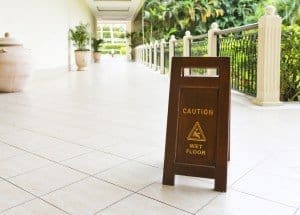
A bride is suing a luxury hotel for more than $250,000 after she slipped on a wet floor and fractured her kneecap on her wedding day. In addition to compensation for injuries, the woman, a hairdresser, wants the hotel to pay for loss of income and the cost to hire cleaners to help around the house, as she is not able to stand for long periods of time.
While $250,000 is well above the average $15,020 payout for a “slip, trip and fall” claim, the majority of claims a hotel will incur over time—and the dollars they will pay—come from guests falling somewhere on the premises. In fact a study based on 17 years of Distinguished Specialty experience and more 27,000 claims showed over 50 percent of all claims were from “slip, trip and falls”.
Common “slip, trip and fall” hazards result from:
- Wet or contaminated floors
- Uneven walking surfaces
- Mats or rugs not lying flat on floor
- Obstruction of walkways
- Inadequate illumination
- Unguarded platforms
What you can do to prevent falls:
- Use the Distinguished Specialty Slip, Trip and Falls Inspection Form to identify and prevent hazards annually.
- Clean up spills immediately.
- Do not leave floors wet after cleaning, or if it’s not possible to completely dry, use wet-floor warning signs.
- Make sure floors, walkways, and platforms are maintained, in good repair and free of obstruction.
- Slip-resistant flooring should be used in areas likely to get wet or subject to frequent spills.
- Ensure floor mats and rugs are securely fixed and do not have curling edges.
- Implement a slip-and-fall prevention policy.
The second leading source of claims within the “slip, trip and fall” category, after uncarpeted floors, is falls on stairs, steps, and ramps. Use our Preventing Falls on Stairs Managing Risk Bulletin in conjunction with our inspection form to help mitigate risk at your property.





